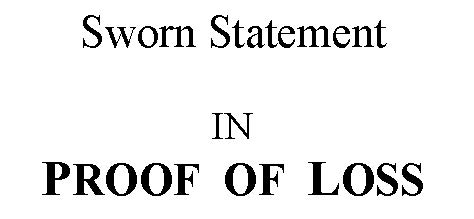One of the basic duties which public adjusters are supposed to accomplish for their policyholder clients is to evaluate the amount of damage and properly file a proof of loss if one is required. I was thinking about this while reading a fairly recent Florida case1 where a public adjuster failed to file a proof of loss on behalf of the policyholder despite the insurance company demanding one in writing. This failure to file a proof of loss cost the policyholder an otherwise valid claim.
In Does a Requested Proof of Loss Have to Be Provided Before Demanding Appraisal or Filing Suit, I tried to make a point about the downside of not complying with a request for a proof of loss:
Proofs of loss were a topic of my first speech to the National Association of Public Insurance Adjusters at Carmel, California, in 1985. Generally, if an insurance company timely demands a proof of loss or if it is required under a policy, and the insurer does not waive the requirement, a proof of loss must be provided.
So, what is the downside to filing a proof of loss if demanded by an insurer? Generally, nothing. What is the downside by refusing to file a proof of loss? Maybe losing the entire claim. So, if an insurer properly asks for a proof of loss, provide a proof of loss.
…
All members of the Florida Association of Public Insurance Adjusters have heard me teach (after I demand that they listen) on numerous occasions that one of the first things which should be done is to determine if a proof of loss is a “demand proof” or a “time limit proof.” Time limit proofs should be filed within a time frame (ask for an extension if one cannot be made on time) and demand proofs should be filed if demanded. The forms insurance companies provide sometimes are not what is required under the policy. So, read what the policy requires and file an appropriate proof of loss.
The basic steps a public adjuster should follow regarding a proof of loss are the following:
- Determine if the policy requires a proof of loss to be filed within a certain amount of time after the loss occurs or within a certain amount of time after a demand.
- Determine what the policy requires to be filed with a proof of loss. This is usually found in the Duties After Loss section of the policy.
- Obtain all the information required for properly filing a proof of loss.
- Fill out the proof of loss form and information required to properly complete the proof of loss requirements and file it with the insurance carrier within the time frames required.
What is required in a proof of loss vary from insurance company and policy form. They are not always the same. In a recent blog post, Failure to Comply with Post-Loss Obligations: Affidavits by Themselves May Not be Enough to Win Summary Judgment Under Florida Rule 1.510, it appeared to me that the insurance companies might be using a checklist to argue every conceivable reason not to pay an otherwise valid claim because a technical requirement of information found in the duties after loss provisions was arguably not met. That post pointed to the insurance company’s argument that the proof of loss was insufficient because a detailed estimate was not provided.
In the case that gave rise to this post, the public adjuster never filed a proof of loss for the policyholder, which led to a loss in court:
Here, the record evidence shows that there was a “total failure” by the insured to comply with the proof-of-loss requirement. The insured did not “cooperate to some degree” with the proof-of-loss requirement. For example, this is not a case where the insured submitted a proof of loss in an untimely manner or submitted a proof of loss that wasn’t properly notarized.
To the contrary, it is undisputed that the insured never submitted a proof of loss after SafePoint requested it. SafePoint requested a proof of loss in its August 2016 email to the public adjuster and in its September 2016 letter to the insured. The question is not whether, in a general sense, the insured cooperated to some degree with SafePoint’s investigation; rather, the question is whether the insured cooperated to some degree with the proof-of-loss condition. That the insured ultimately submitted an estimate and other documents is irrelevant. See Rodrigo, 144 So. 3d at 692 (‘While the insured argued that she provided the insurer with bills, estimates, invoices, and other documents to prove her damages, she failed to file a sworn proof of loss.’).
The appellate court obviously focused on the sworn form not being provided rather than the estimates and other information sent by the public adjusters. While this technical avoidance of paying an otherwise valid claim and having a forfeiture occur may seem harsh, the much safer practice is to avoid all of this by filing a proof of loss when asked to do so with the information required in the insurance policy.
Thought For The Day
A proof is a proof. What kind of a proof? It’s a proof. A proof is a proof. And when you have a good proof, it’s because it’s proven.
—Jean Chretien
_______________________________
1 Edwards v. SafePoint Ins. Co., 318 So.3d 13 (Fla. 4th DCA 2021).




